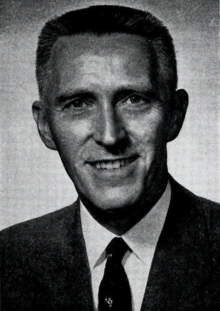Leo Hoegh | |
|---|---|
 | |
| Director of the Office of Civil and Defense Mobilization | |
| In office July 1, 1958 – January 20, 1961 | |
| President | Dwight D. Eisenhower |
| Preceded by | Position established |
| Succeeded by | John S. Patterson (Acting) |
| Administrator of the Federal Civil Defense Administration | |
| In office July 19, 1957 – July 1, 1958 | |
| President | Dwight D. Eisenhower |
| Preceded by | Lewis Berry (Acting) |
| Succeeded by | Position abolished |
| 33rd Governor of Iowa | |
| In office January 13, 1955 – January 17, 1957 | |
| Lieutenant | Leo Elthon |
| Preceded by | Leo Elthon |
| Succeeded by | Herschel C. Loveless |
| Attorney General of Iowa | |
| In office February 1953 – January 13, 1955 | |
| Governor | William S. Beardsley Leo Elthon |
| Preceded by | Robert L. Larson |
| Succeeded by | Dayton Countryman |
| Personal details | |
| Born | Leo Arthur Hoegh March 30, 1908 Audubon, Iowa, U.S. |
| Died | July 15, 2000 (aged 92) Colorado Springs, Colorado, U.S. |
| Political party | Republican |
| Education | University of Iowa (BA, LLB) |
| Military service | |
| Allegiance | |
| Branch/service | |
| Unit | 104th Infantry Division |
| Awards | Bronze Star (with oak leaf cluster) Croix de Guerre (with palm) Legion of Honour |
Leo Arthur Hoegh (/hɔɪɡ/;[1] March 30, 1908 – July 15, 2000) was a decorated U.S. Army officer, lawyer, and politician who served as the 33rd governor of Iowa from 1955 to 1957.
His record of public service included important contributions to his home state and to his country.[2] His career in elective office came to an early end, after his willingness to raise taxes to jump-start improvements to Iowa's roads and schools alienated his conservative Republican allies, and handed Democratic gubernatorial nominee Herschel C. Loveless an issue to exploit.[3]
- ^ Obituary, Leo Hoegh, 92, Civil Defense Chief for Eisenhower, New York Times, 2000-07-24, accessed June 15, 2008.
- ^ Distinguished Alumni Award, University of Iowa Alumni Association, 1989, accessed June 15, 2008.
- ^ "Against the Anthills,"Time Magazine, October 22, 1956.